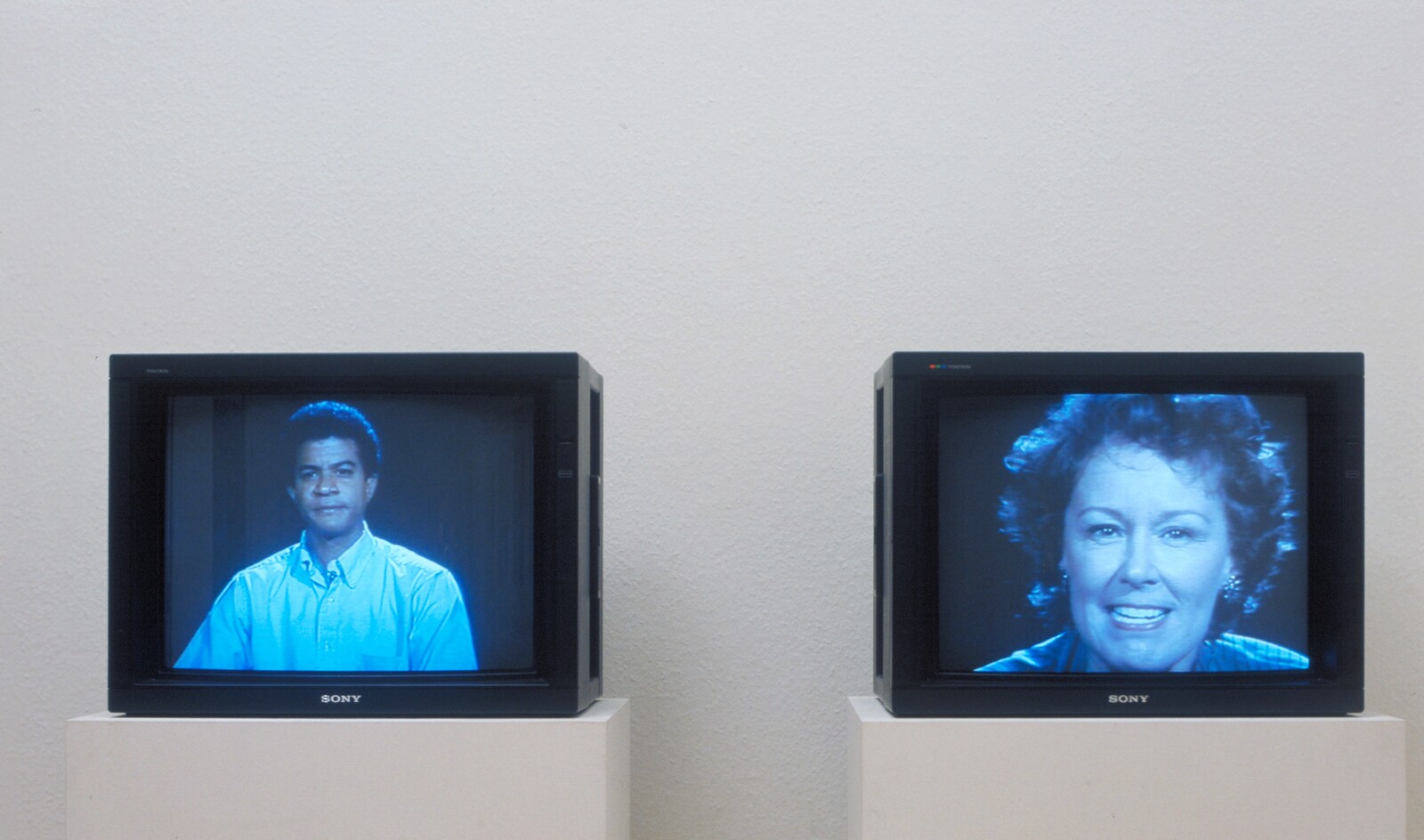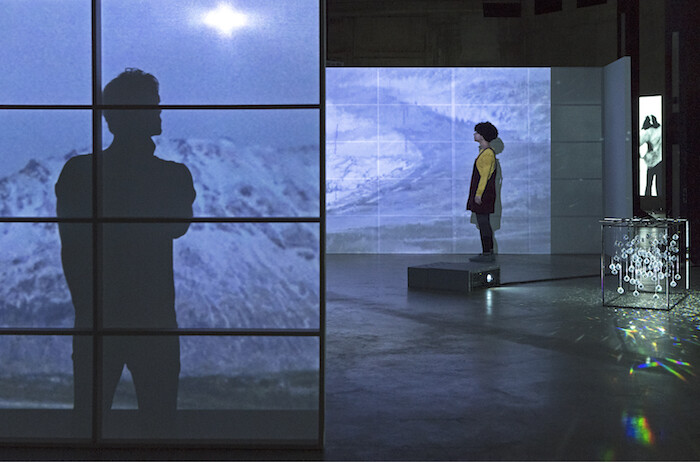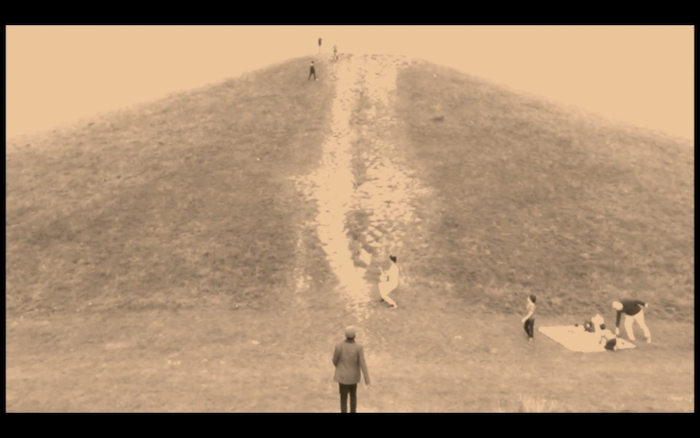Categories
Subjects
Authors
Artists
Venues
Locations
Calendar
Filter
Done
November 5, 2020 – Review
Bruce Nauman
Kevin Brazil

Even before you enter Tate Modern’s Bruce Nauman retrospective, you are put on edge. Approaching the galleries, you hear a man and woman shout “I hate, you hate, we hate!” from the screens of Good Boy Bad Boy (1985). As you queue at the exhibition’s entrance, Setting a Good Corner (Allegory & Metaphor) (1999), a video of Nauman erecting a wooden fence, assaults you with the nerve-shredding sound of a chainsaw. These sounds are deeply discomforting, but that which makes you uncomfortable is also that which you cannot ignore. Discomfort makes you aware of your own body: the unease caused by screaming, or the grinding of a saw, manifests in the tensing of muscles. Yet discomfort, in never becoming unbearable, induces self-reflection: you remain aware of what unsettles you and why. Attentive, aware of one’s body, reflective: discomfort shares much with how we think we should experience art. Why then does it feel so bad?
Discomfort as a state of awareness, this retrospective reveals, has been one of Nauman’s consistent preoccupations across six decades of work. Much has been made of Nauman’s exploration of media after Conceptual Art; many have traced his influence on later artists. Yet Nauman’s achievement …
October 7, 2019 – Feature
London Roundup
Chris Fite-Wassilak
%20provisioning_hr.jpg,1600)
The world is burning. This is not a metaphor. The sky is bleached a searing lime green, tinged with burned orange that reflects off relentless choppy waves. Suddenly, the sky goes blood red and the horizon blackens, the sun a dull hole punched in the sky. Our view shifts, panning quickly to the left, then back again, as if searching for something, anything. The sky then changes again to a blinding sherbet yellow. The screen depicting this scene, mounted on a metal rack above a whirring circuit board, gives us a certain vision of our current reality. The shifting colors are a translation of information from a small atmospheric monitor mounted on the back of the rack. It’s not clear what directly causes the hues to brighten or waves to get that bit higher or more intense in Yuri Pattison’s sun[set] provisioning (2019) at mother’s tankstation—whether the car exhaust from the street outside, or the hungover breath from bodies in the room might make the scene that bit more trippy. The contraption offers a heavily mediated fiction, but it also makes an actuality visible and present: a drowned world, made hallucinatory and beautiful by toxins that saturate the air and …
October 12, 2018 – Feature
London Roundup
Mariana Cánepa Luna

Just as Frieze Art Fair opened last Wednesday, Prime Minister Theresa May gave her keynote speech—and dared to dance again—at the Conservative Party Conference in Birmingham. She announced that freedom of movement would be terminated “once and for all” by limiting access to “highly skilled workers” (in short, migrants earning over 30,000 British pounds per year). Countless art professionals earn much less (including entry-level curatorial staff at Tate, and yours truly), as well as doubtless many of the myriad gallery and museum folks involved in the city-wide jamboree of Frieze week. How do we imagine London’s contemporary art ecology post-Brexit, a scene that has grown exponentially since Tate Modern’s opening in 2000 and the first Frieze Art Fair in 2003? The question of how the 2019 edition of the fair is going to be affected was the elephant in the tent. Most people I asked shrugged: negotiations are still ongoing, consequences are yet to be seen. “It’ll be fiiiiine,” a London museum director told me. “Maybe we’ll visit a smaller fair, like the first editions—remember those days?” opined a British gallerist friend working in New York. Although one could put this upbeat denial down to the cliché of dark British …
July 3, 2018 – Review
Joan Jonas
Philomena Epps

When I was a child, I received a disco ball as a birthday gift. Hung haphazardly above my bed and lit by a repurposed old desk lamp, it reflected a scintillating constellation across the ceiling. In a flick of a switch, the quotidian transformed: I had entered a secret world. A kind of Proustian magic occurs when an artwork triggers not only an involuntary memory but an ineffable bodily feeling. Walking into Joan Jonas’s installations—Reanimation (2010/2012/2013) and Wind (1968)—in the East Tanks of Tate Modern did precisely that. The cavernous space had become an enigmatic new universe: the rough walls animated by shimmering video projections, with crystal spheres refracting flickering light, and the howling noise of gale-force wind intertwining with strange percussive sounds.
Jonas’s oeuvre eludes genre. Throughout her career, she has blended technology—video screens, re-recorded backdrops, overheard projectors—into historical systems of communication, engaging with traditions of shadow puppetry, mythology, ritualistic music, and Noh theatre. Her work travels from factory lofts to wasteland docks, across landscapes and seascapes, deserts, cities, and hilltops. Jonas’s show at Tate Modern eschews a chronological retrospective in favor of a nonlinear survey paired with live performance and cinema programs. In alignment with Aby Warburg’s logic of …
November 9, 2016 – Review
“Frieze Film”; “Experimenta”; Philippe Parreno’s “Anywhen”
Herb Shellenberger

“A repetitive moment becomes eternity.” This fragment of speech, ringing through Tate Modern’s Turbine Hall in Philippe Parreno’s installation Anywhen (2016), might equally describe the frustration or elation of viewers’ experiences of moving image artworks. This season’s blockbuster exhibitions of film and video—Frieze Film (October 6–9, 2016), BFI London Film Festival’s Experimenta (October 6–16), and Parreno’s commission for Tate Modern (October 4–April 7, 2017)—showcased new works in these media through a variety of structures, some more effective than others.
When considered against the relative paucity of moving image works in the booths of Frieze Art Fair this year, the Frieze Film project—which commissioned work by Samson Kambalu, Rachel Maclean, Shana Moulton, and Ming Wong—seemed like an effort to redress the balance. The works were shown at scheduled times in the Frieze auditorium and also on national television as part of Channel 4’s Random Acts strand, which inserts three-minute shorts between programs. But to those already familiar with the oeuvres of the featured artists, this year’s commissions felt too brief; introductions to their style and ideas, rather than fully formed works.
When it is installed in an exhibition space, as at the 2015 Venice Biennale and now at London’s Whitechapel Gallery (23 August, …
June 21, 2016 – Review
Tate Modern’s Switch House
Ben Eastham

“When racism and sexism are no longer fashionable,” the Guerilla Girls asked in 1989, “what will your art collection be worth?” Predicting that “the art market won’t bestow mega-buck prices on the work of a few white males forever,” their printed notice listed 67 female artists (several of whom are now on show in the refurbished Tate Modern), at least one work by each of whom could be acquired for the price of a single Jasper Johns painting. Once fly-posted around SoHo in a grassroots campaign by the anonymous collective to protest against institutional discrimination in the art world, the poster is now prominently displayed in the world’s most visited museum dedicated to modern and contemporary art. The framed portfolio of which it is a part, Guerrilla Girls Talk Back (1985–90)—a scathing critique of the role and representation of women and ethnic minorities in twentieth-century Western culture—hangs opposite Marilyn Diptych (1962), Andy Warhol’s paean to American sex, money, and cultural imperialism.
The new Tate Modern brings forward the future envisaged by the Guerrilla Girls at the expense of a past embodied in Marilyn. The opening of a vast new wing—a coiled, ten-storey ziggurat designed by Herzog & de Meuron—is the occasion …